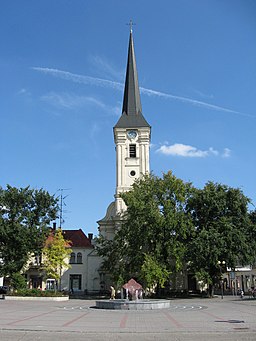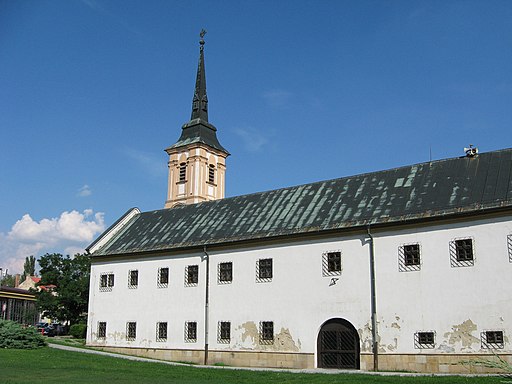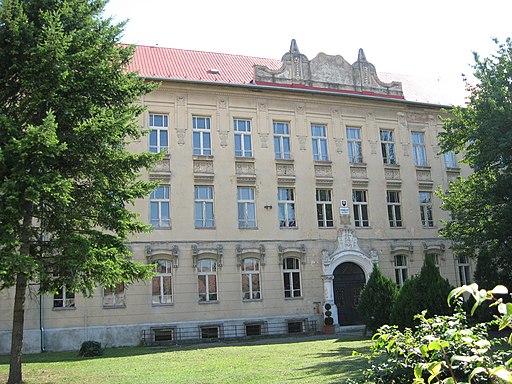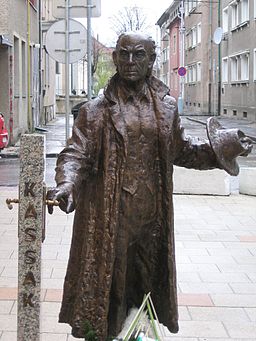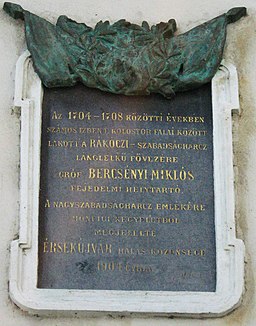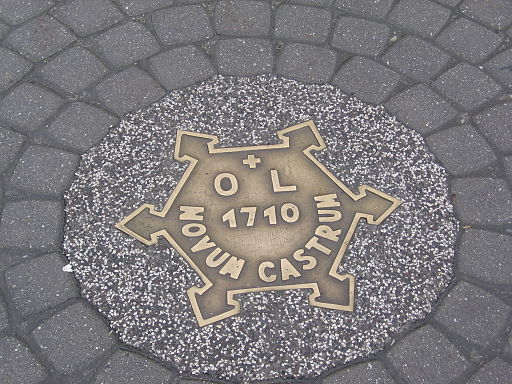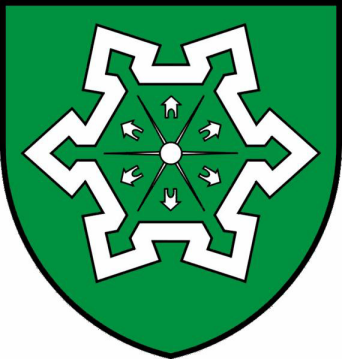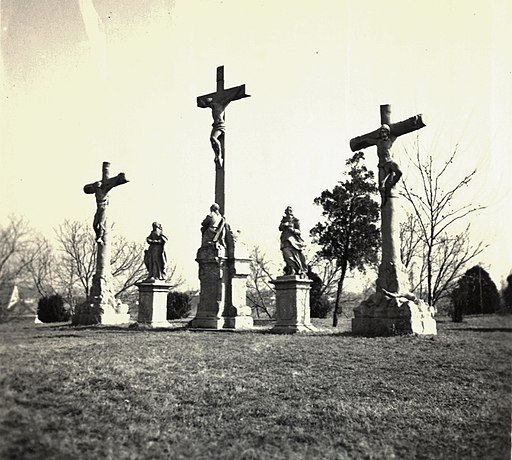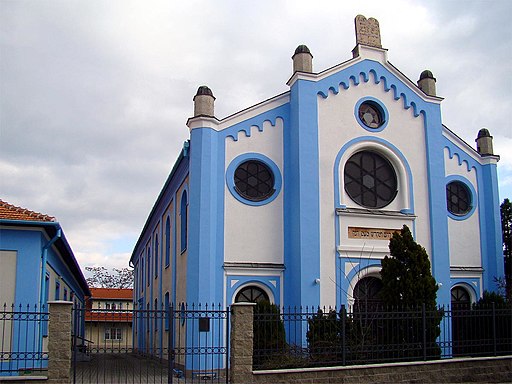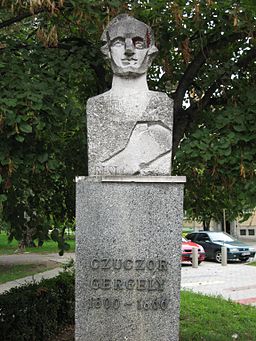Érsekújvár
Historical Hungarian county:
Nyitra
GPS coordinates:
47.986096, 18.163307
Population
Population in 1910
| Total |
16228 |
| Hungarian |
91.43% |
| German |
2% |
| Slovak |
5.94% |
The town was created from scratch in the 1570s inside of one of the most modern fortresses of Europe that was built to protect Hungary from the Turks. In 1663 the fortress could not resist the Turks, who heavily outnumbered the defenders, but it proved to be a more effective tool in the hands of the Hungarian insurgents fighting against the tyranny of the Habsburg emperors. It happened due to this fact as well that the emperor ordered the complete demolition of the fortress in the first half of the 18th century, but the town's street system preserved its shape quite well. The greatest tragedy struck the town on March 14, 1945, when the British-American bombers allied with the Soviet communists destroyed two-thirds of the town together with most of the historic buildings and killed 4,000 innocent people as well. The predominantly Hungarian population of the town was humiliated twice by the invading Czechoslovak army. In 1919 they tore down the statue of Kossuth Lajos, the political leader of the Hungarian Revolution and War of Independence in 1848, and in 1945 they destroyed the country flag erected on the same spot after the town returned to Hungary in 1938. Due to the persecutions during the 20th century Hungarians are now in a minority in the town.
Check out other towns in Upper Hungary (Slovakia) as well!
895
Arrival of the Hungarians
Little more...
895
The alliance of the seven Hungarian tribes took possession of the then largely uninhabited Carpathian Basin. Until then, the sparse Slavic population of the north-western Carpathians had lived under Moravian rule for a few decades after the collapse of the Avar Khaganate in the early 9th century.
1000
Foundation of the Hungarian Kingdom
Little more...
1000
The Kingdom of Hungary was established with the coronation of King Stephen I. He converted the Hungarians to Christianity and created two archdioceses (Esztergom and Kalocsa) and ten dioceses. He divided Hungary into counties led by ispáns, who were appointed by the king.
1526
Battle of Mohács and the splitting of Hungary into two parts
Little more...
1526
Sultan Suleiman I launched a war against Vienna, instigated by the French. Ferdinand I, Duke of Austria, was the brother-in-law of King Louis II of Hungary. The army of the Ottoman Empire defeated the much smaller Hungarian army at Mohács, and King Louis II died in the battle. A group of the barons elected Ferdinand I of the House of Habsburg to the throne, who promised to defend Hungary from the Turks. He was the younger brother of the most powerful European monarch Emperor Charles V. But the nobility chose the most powerful Hungarian baron, Szapolyai János, who was also crowned as King John I. The country was split in two and a decades-long struggle for power began.
1541
The Turkish occupation of the capital, Buda, and the division of Hungary into three parts
Little more...
1541
The Turks conquered Buda, the capital of Hungary, after the death of King John I. The central part of the country was under Turkish rule for 150 years. The western and northern parts (including present-day Slovakia) formed the Kingdom of Hungary ruled by the Habsburg emperors. The eastern parts (now mainly under Romanian rule) were ruled by the successors of King John I of Hungary, who later established the Principality of Transylvania.
1545-1546
Várdai Pál, Archbishop of Esztergom constructed a wooden palisade with four bastions on the left bank of the Nyitra river to protect his lands.
between 1553-1568
Oláh Miklós, Archbishop of Esztergom reinforced the castle. It was called Castrum Novum. The common Hungarian name was Oláhújvár (Oláh New Castle), referring to the name of the archbishop.
1570
The establishment of the Principality of Transylvania
Little more...
1570
John II (John Sigismund), the son of King John I of Hungary, renounced the title of King of Hungary in favor of King Maximilian of the House of Habsburg, and henceforth held the title of Prince. This formally created the Principality of Transylvania, which was the eastern half of Hungary not ruled by the Habsburgs and was also a vassal of the Ottoman Empire. John II died in 1571, after which the three nations of Transylvania (the Hungarian nobility, the Székelys and the Saxons) elected the prince.
July 7, 1571
The War Council of Vienna decided to build a new fort on the right bank of river Nyitra, because the old one was obsolete and impossible to protect.
1573-1580
The construction of the new fort. The construction was managed by Zserotin Frigyes based on the plans of the Italian architects Ottavio és Giulio Baldigara. The hexagonal fort incorporated an entire town with rectangular street system. It was one of the most modern forts of the era.
October 2, 1580
The fort was inaugurated. Forgách Simon became the Captain of Érsekújvár.
1584-1585
A Catholic parish church and a school was built.
1604-1606
Uprising of Bocskai István
Little more...
1604-1606
The alliance of the Habsburgs and the Principality of Transylvania was defeated by the Ottoman Empire in the Fifteen Years' War. The war devastated Transylvania, which was occupied by the Habsburg imperial army, and General Basta introduced a reign of terror. The nobility and the burghers were upset about the terror, the plundering mercenaries and the violent Counter-Reformation. Bocskai István decided to lead their uprising after the Habsburg emperor tried to confiscate his estates. Bocskai also rallied the hajdú warriors to his side. He was elected Prince of Transylvania and soon liberated the Kingdom of Hungary from the Habsburgs. In 1605 Bocskai István was crowned King of Hungary with the crown he received from the Turks.
late 16th century
A Reformed church was built, which was the largest church in the town.
October 17, 1605
After several months of siege, Érsekújvár surrendered to the army of Bocskai István. It was due to a secret agreement between High Prince Matthew and Illésházy István that the fort surrendered to Homonnai Drugeth Bálint, the commander of Bocskai István. They wanted to prevent the Turks, who helped Bocskai in the siege, from capturing the important fort. The Hungarians did not let the Turks into the fort, after they took it over from the Imperials.
23 June 1606
Peace of Vienna
Little more...
23 June 1606
Bocski István made peace with Emperor Rudolf. Their agreement secured the constitutional rights of the Estates of Hungary, and the freedom of religion. The counties of Szatmár, Bereg and Ugocsa were annexed to the Principality of Transylvania. Bocskai died of illness in the same year, leaving to his successors the idea of unifying Hungary from Transylvania.
1606
According to the Peace of Vienna that ended the Bocskai-uprising, the Imperials got Érsekújvár back.
1619
The campaign of Prince Bethlen Gábor of Transylvania in the Thirty Years' War
Little more...
1619
At the beginning of the Thirty Years' War (1618-1648), Prince Bethlen Gábor of Transylvania went to war against the Habsburg emperor as an ally of the rebelling Czech-Moravian-Austrian estates. The whole Kingdom of Hungary joined him, only the Austrian defenders of Pozsony had to be put to the sword. With his allies, he laid siege to Vienna. However, he was forced to abandon the siege because the Habsburg-loyal Hungarian aristocrat Homonnai Drugeth György attacked his heartland with Polish mercenaries. On 25 August 1620, the Diet of Besztercebánya elected Bethlen Gábor King of Hungary as vassal of the Turks. He continued to fight after the defeat of the Czechs at White Mountain on 8 November 1620, but without real chance to achieve decisive victory, he decided to come to an agreement with Emperor Ferdinand II.
September 1619
The fort peacefully surrendered to Prince Bethlen Gábor of Transylvania.
May 29 - July 21, 1621
The Imperial siege of Érsekújvár. The army sent by Prince Bethlen to liberate the fort arrived on the 13th of June. Thurzó Szaniszló successfully defended the fort. The Imperial commander Buquoi died in the fights.
31 December 1621
Peace of Nikolsburg
Little more...
31 December 1621
Prince Bethlen Gábor of Transylvania made peace with Emperor Ferdinand II. Their agreement secured the constitutional rights of the Estates of Hungary, and later it was supplemented with the freedom of religion. Bethlen renounced the title of King of Hungary in exchange for seven counties of the Upper Tisza region (Szabolcs, Szatmár, Bereg, Ugocsa, Zemplén, Borsod, Abaúj) for the rest of his life, other estates in Hungary as his private property and the imperial title of Duke of Oppeln and Ratibor (Opole and Racibórz), one of the Duchies of Silesia. Prince Bethlen went to war against the Habsburgs in 1623 and 1626, but was unable to negotiate more favourable terms.
1621
According to the Peace of Nikolsburg the town returned to the emperor, Ferdinand II.
17th century
A Reformed collage was opened.
1620s
Pázmány Péter, Archbishop of Esztergom constructed the Archbishop's Palace and invited Franciscan monks to the town.
May 24, 1631
Archbishop Pázmány Péter consecrated a Franciscan church and a monastery.
1652
At Nagyvezekény Forgách Ádám, Captain of Érsekújvár, defeated an army of 4,000 Turks with his 1,300 men and freed 150 captives.
August 4, 1663
Two messengers brought fake news to Captain Forgách Ádám about the Turkish army having been split into two parts by the flood that swept away the pontoon bridge at Párkány. The Captain, in order to take advantage of the situation, marched out with 5,000 men to attack the Turks.
August 6, 1663
At Köbölkút, the Hungarians suffered a complete defeat from Köprülü Ahmed's Turkish army of 20-25 thousand soldiers (4 or 5 times larger than the Hungarian army).
August 18, 1663
The Turks besieged the fort. The Turkish army mounted to 100-120 thousand after the Tatar, Cossack, Moldavian and Wallachian auxiliary troops arrived.
September 22, 1663
The wall collapsed at the Frigyes (Frederik) bastion.
September 24, 1663
The defenders of Érsekújvár surrendered in exchange for free retreat. The neighborhood was left unprotected and the Turks caused large destruction. Soon after, the town of Nyitra fell to the enemy.
October 9, 1683
The army of the Holy League defeated the Turks at Párkány.
October 28, 1683
After four days of siege Esztergom surrendered to the army of the Holy League. Érsekújvár was left without supply.
July 7, 1685
The main army of Charles V, Duke of Lorraine arrived under Érsekújvár, which had already been encircled by Heister.
August 16, 1685
Charles V, Duke of Lorraine, defeated the Turkish army that was supposed to liberate Érsekújvár of the siege next to the village of Tát.
August 19, 1685
Érsekújvár was occupied by the Imperials with one last attack.
1686
Recapture of Buda and the liberation of Hungary from the Turks
Little more...
1686
The army of the Holy League recaptured Buda from the Turks by siege. In 1687, the Imperial army invaded the Principality of Transylvania. The liberation was hindered by the French breaking their promise of peace in 1688 and attacking the Habsburg Empire. By 1699, when the Peace of Karlóca was signed, all of Hungary and Croatia had been liberated from the Ottoman Empire with the exception of Temesköz, the area bounded by the Maros, the Tisza and the Danube rivers. It was not until the Peace of Požarevac in 1718 that Temesköz was liberated from the Turks. However, the continuous war against the Turkish invaders and the Habsburg autocracy, which lasted for more than 150 years, wiped out large areas of the Hungarian population, which had previously made up 80% of the country's population, and was replaced by Vlachs (Romanians), Serbs and other Slavic settlers and Germans. The Habsburgs also favoured the settlement of these foreign peoples over the 'rebellious' Hungarians.
1691
Emperor Leopold I gave back the town to Széchényi György, Archbishop of Esztergom in return for 10 thousand florins. The archbishop granted the settlement town status.
1703-1711
Hungarian War of Independence led by Prince Rákóczi Ferenc II
Little more...
1703-1711
After the expulsion of the Turks, the Habsburgs treated Hungary as a newly conquered province and did not respect its constitution. The serfs rose up against the Habsburg ruler because of the sufferings caused by the war and the heavy burdens, and they invited Rákóczi Ferenc II to lead them. Trusting in the help promised by King Louis XIV of France, he accepted. Rákóczi rallied the nobility to his side, and soon most of the country was under his control. The rebels were called the kurucs. In 1704, the French and the Bavarians were defeated at the Battle of Blenheim, depriving the Hungarians of their international allies. The Rusyn, Slovak and Vlach peasants and the Saxons of Szepes supported the fight for freedom, while the Serbs in the south and the Saxons in Transylvania served the Habsburgs. Due to lack of funds Rákóczi could not raise a strong regular army, and in 1710, Hungary was also hit by a severe plague. Rákóczi tried unsuccessfully to forge an alliance with Tsar Peter the Great of Russia. In his absence, without his knowledge, his commander-in-chief, Károlyi Sándor, accepted Emperor Joseph I's peace offer. The Peace of Szatmár formally restored the Hungarian constitution and religious freedom and granted amnesty, but did not ease the burden of serfdom. Rákóczi refused to accept the pardon and went into exile. He died in Rodosto, Turkey.
November 16, 1704
Érsekújvár was occupied by the kuruc insurgents without a fight.
May 20, 1706
Prince Rákóczi Ferenc II signed the truce with the Imperials in Érsekújvár. A few issues of the kuruc war newspaper, the Mercurius Veridicus ("Truth telling Mercur”) was published here.
1708
Heister started to fire at the town, but he could not occupy it. The kuruc commander Ocskay László switched to the Imperials.
January 3, 1710
The kuruc insurgents caught the traitor Ocskay during a raid, and executed him on the main square of Érsekújvár.
September 14, 1710
The Imperials besieged the town.
September 23, 1710
The Imperials occupied the town.
1724-25
The fortifications were demolished at the order of Emperor Charles II.
1848-1849
Hungarian Revolution and War of Independence
Little more...
1848-1849
Following the news of the Paris Revolution on 22 February 1848, the Hungarian liberal opposition led by Kossuth Lajos demanded the abolition of serfdom, the abolition of the tax exemption of the nobility, a parliament elected by the people, and an independent and accountable national government. The revolution that broke out in Pest on 15 March expressed its demands in 12 points, which, in addition to the above mentioned, included the freedom of the press, equality before the law, the release of the political prisoners and the union with Transylvania. A Hungarian government was formed, Batthyány Lajos became prime minister, and on 11 April Emperor Ferdinand V ratified the reform laws. On August 31 the Emperor demanded the repeal of the laws threatening with military intervention. In September the Emperor unleashed the army of Jelacic, Ban of Croatia, on Hungary, but they were defeated by the Hungarians in the Battle of Pákozd on 29 September. An open war began for the independence of Hungary. The Habsburgs incited the nationalities against the Hungarians. The Rusyns, the Slovenes and most of the Slovaks and Germans supported the cause persistently, but the Vlachs (Romanians) and the Serbians turned against the Hungarians. The glorious Spring Campaign in 1849 led by General Görgei Artúr liberated almost all of Hungary. On 1 May 1849, Emperor Franz Joseph, effectively admitting defeat, asked for the help of Tsar Nicholas I of Russia, who sent an intervention army of 200,000 soldiers against Hungary. The resistance became hopeless against the overwhelming enemy forces and on 13 August Görgei Artúr surrendered to the Russians at Világos. Bloody reprisals followed, and on 6 October 1849, 12 generals and a colonel of the Hungarian Revolution, the martyrs of Arad, were executed in Arad. On the same day, Batthyány Lajos, the first Hungarian Prime Minister, was executed by firing squad in Pest. The Habsburgs introduced total authoritarianism in Hungary, but they also failed to fulfil their promises to the nationalities that had betrayed the Hungarians.
1848
The revolution and war of independence ended the archbishop's control over the town.
1851
The town got railway connection on the Budapest–Érsekújvár–Pozsony–Marchegg line. It was the most important railway line in Hungary because it connected Budapest to Vienna.
1867
Austro-Hungarian Compromise
Little more...
1867
The Habsburg Empire was weakened by the defeats it suffered in the implementation of Italian and German unity. The Hungarians wanted to return to the reform laws of 1848, but they did not have the strength to do so. Emperor Franz Joseph and the Hungarian opposition, led by Deák Ferenc, finally agreed to restructure the Empire and abolish absolutism. Hungary was given autonomy in its internal affairs, with its own government and parliament, which was essential for the development of its economy and culture. However, foreign and military affairs remained in the hands of the Habsburgs and served their aspiration for becoming a great power. The majority wanted Hungary's independence, but they were excluded from political power.
1889
Brick factory was established.
1900
A tannery was established, which produced shoes as well from 1904.
1902
Gasworks were established.
1906
A flax processor was built.
1914-1918
World War I
Little more...
1914-1918
As part of the Austro-Hungarian Monarchy, Hungary took part in the war on the side of the Central Powers.
November 1918 - January 1919
The Czech, Romanian and Serbian occupation of Hungary
Little more...
November 1918 - January 1919
In Hungary, the freemasonic subversion brought the pro-Entente Károlyi Mihály to power. The new government, naively trusting the Entente powers, met all their demands and disbanded the Hungarian military, which rendered the country completely defenseless in the most dire need. Under French and Italian command, Czech, Romanian and Serbian troops invaded large parts of Hungary, where they immediately began the takeover. They fired Hungarian railway workers, officials and teachers, banned the use of the Hungarian language, abolished Hungarian education, and disposed of everything that reminded them of the country's Hungarian past. Hundreds of thousands of Hungarians were forced to leave their homeland, and the forcible assimilation of the remaining Hungarians was begun.
January 8, 1919
The Czechoslovaks invaded Érsekújvár.
21 March - 1 August 1919
Communist takeover and the Northern Campaign
Little more...
21 March - 1 August 1919
After the Entente put vast areas with a Hungarian population under foreign administration, the pro-Entente government resigned and the traitorous Prime Minister Károlyi Mihály handed over power to the communists, who had little support anyway. They raised the Hungarian Red Army, which liberated large parts of northern Hungary from Czech occupation in the 'Northern Campaign'. The aim was to unite with the Russian Red Army, which ultimately failed because of the Russians' defeat. French Prime Minister Clemenceau promised the Jewish Kun Béla that he would recognise the Hungarian Soviet Republic and invite it to the peace conference if it would call back the army from northern Hungary. Calling back the army demoralized the soldiers, who fought for their homeland and not for communism. Clemenceau broke his promise and let the Romanian horde cross the Tisza River and capture Budapest.
June 3, 1919
The army of the Hungarian Soviet Republic liberated Érsekújvár from the Czechoslovak invaders.
June 19-20, 1919
The Czechoslovaks invaded the Hungarian town again.
4 June 1920
Trianon Dictate
Little more...
4 June 1920
Hungary was forced to sign the Treaty of Trianon, although the country was not invited to the peace talks. Hungary lost two thirds of its territory that had belonged to it for more than 1000 years. One-third of the Hungarian population came under foreign rule. On the basis of the national principle, countries with a more mixed and less ethnically balanced composition than the former Hungary were created, such as Czechoslovakia and the Kingdom of Serbs, Croats and Slovenes (later Yugoslavia). For example, while 48% of the population of the territory ceded to Czechoslovakia was Slovak and 30% Hungarian, 54% of the population of the former Hungary was Hungarian and 10.6% Slovak. And in the territory that is now part of Serbia, the Hungarians outnumbered the Serbs. The part of the territory allocated to Romania from Hungary was larger than the remaining territory of Hungary, despite the fact that there were 10 million Hungarians and less than 3 million Romanians in the former Hungary. While Hungary used to have the most liberal nationality policy in Europe, the successor states had no respect at all for the national and cultural rights of the indigenous Hungarians and engaged in forced assimilation. The Trianon Dictate destroyed the organic economic unity of the region. Before the First World War, Hungary had a dynamic economy, more advanced than Spain's. After 1920, the successor states formed the so-called "Little Entente", putting Hungary under an economic blockade and sabotaging it on the international stage.
2 November 1938
First Vienna Award
Little more...
2 November 1938
Under the First Vienna Award, Hungary regained 11,927 km2 of territory from Czechoslovakia. Its population was 869 thousand people, 86.5% of whom were Hungarian. France and Great Britain did not take part in the decision taken by Germany and Italy, citing disinterest, but acknowledged its validity.
November 2, 1938
Érsekújvár returned to Hungary according to the First Vienna Award.
November 8, 1938
The Hungarian army marched into Érsekújvár according to the First Vienna Award.
October 7, 14, 1944
British-American bombing.
March 14, 1945
British-American bombing. Two thirds of the town was destroyed together with most of the historic buildings. 4,000 innocent people were killed.
Autumn 1944 - Spring 1945
Soviet occupation
Little more...
Autumn 1944 - Spring 1945
The Soviet Red Army occupied Hungary and Slovakia, which resulted in the recreation of Czechoslovakia.
March 29, 1945
The Soviets invaded Érsekújvár.
5 April 1945
Beneš decrees and the persecution of Hungarians
Little more...
5 April 1945
In Hungarian-majority Kassa, the president of occupying Czechoslovakia, Edvard Beneš, promulgated his government program, the so-called Beneš decrees. As part of this, the Hungarian population was deprived of their rights. Their complete expulsion was planned, with the support of the Soviet Union, and only the veto of the USA prevented it. Under the 'Reslavakization' programme, only those Hungarians who recognised themselves as Slovaks were allowed to regain their rights, thus renouncing all linguistic and cultural rights. In the violent expulsions that followed, nearly 200,000 Hungarians were deprived of their property and expelled from their homeland on the basis of their nationality.
1945
One of many internment camps where the Czechoslovaks gathered the native Hungarians they wanted to expel because of their nationality operated in Érsekújvár.
1946
The Archbishop's Palace, which was only slightly damaged in the bombings, was demolished by the Czechoslovaks.
1947
Paris Dictate
Little more...
1947
The Paris Dictate, in accordance with Soviet interests, did not recognise the just territorial revisions made by the two Vienna decisions and handed the reclaimed Hungarian-majority territories back to Czechoslovakia, Romania and Yugoslavia, where the Hungarians were subjected to severe atrocities, expulsions and deprivation of rights. It also seceded three more villages south of Pozsony from Hungary to Czechoslovakia.
1947-48
The remaining Hungarian population was expelled, Slovaks flooded the town.
1 January 1993
Dissolution of Czechoslovakia
Little more...
1 January 1993
Czechoslovakia disintegrated due to ethnic differences between Czechs and Slovaks, shortly after the withdrawal of Soviet tanks. Slovakia was formed entirely from territory carved out of historic Hungary, and Slovak national identity is still largely based on falsified history and artificial hatred of Hungarians. Despite deportations, expulsions, forced assimilation and strong economic pressure, there are still nearly half a million Hungarians living in the country.
Sights
All
Churches, religious buildings
Cultural facilities
Memorials
Churches, religious buildings
True Cross Roman Catholic Church
kostol Povýšenia svätého kríža
Show on map
Visit
True Cross Roman Catholic Church
History
The church was built between 1584 and 1585 in late Gothic style. In 1605 Homonnai Drugeth Bálint, the commander of Bocskai István, gave the church to the Protestants after he occupied the town. It had to be nearly completely rebuilt in 1612. In 1633 Archbishop Pázmány Péter of Esztergom renovated the church. After the Turks occupied Érsekújvár, the church was used as a minaret between 1633 and 1685. In 1693 Archbishop Széchényi György repaired the church. In 1787 Archbishop Batthiany György renovated the church. In 1877 Archbishop Simor János of Esztergom ordered the renovation of the church in neo-Classicist style and after its completion he dedicated it to the Holy Cross.
Stigmatisation of Saint Francis of Assisi Franciscan Church and Monastery
Františkánsky kostol a kláštor
Originally:
church and monastery
Show on map
Visit
Stigmatisation of Saint Francis of Assisi Franciscan Church and Monastery
History
It was built between 1626 and 1631 and was consecrated by Archbishop Pázmány Péter of Esztergom. After the Turks occupied Érsekújvár, the tower of the church was used as a minaret between 1633 and 1685.
In 1842 a lower grammar school was established in the monastery. The building was damaged in the wars of the 20th century and lost its Baroque appearance. It has been inhabited by Franciscans again since 1991. During the Hungarian War of Independence of Prince Rákóczi Ferenc II between 1703 and 1711, the Hungarian commander Bercsényi Miklós lived in the monastery for some time. In 1906 a plaque was unveiled in his memory.
There is also a plaque of Archbishop Széchényi György of Esztergom, who granted Érsekújvár town status in 1691.
A plaque commemorates the priests and monks held captive in the building by the Communists between 1950 and 1951.
The Franciscan monk P. Bartalos Lajos Engelbert also has a memorial plaque on the building.
Calvinist Church
Reformovaná Cirkev
Show on map
Visit
Calvinist Church
History
The construction started in 1941, when the Hungarian town was again part of Hungary. The plans were prepared by Szegheő Zsigmond, the town's councilman. The church was consecrated in 1942.
Lutheran Church
Kostol Evanjelickej cirkvi
Show on map
Visit
Lutheran Church
History
It was built in 1905 in neo-Gothic style.
Trinity Chapel
Kaplnka sv. Trojice
Show on map
Visit
Trinity Chapel
History
It stands on the site of the cemetery demolished in 1872. It was built by Skultéty Jakab. Bernolák Antal, dean of Érsekújvár, rests here. He worked in the town from 1797 to 1813. He is the creator of the Slovak literary language. He was the firts to consider the Slovak to be a separate language and not only a rough dialect of the Czech language.
St. Anthony Chapel
Kaplnka sv. Antona
Show on map
Visit
St. Anthony Chapel
History
Virgin Mary Chapel
Kaplnka sv.Marie
Show on map
Visit
Virgin Mary Chapel
History
It was built in the second half of the 18th century.
St. Anne Chapel
Kaplnka sv. Anny
Show on map
Visit
Calvary
Kaplnka na kalvarii
Show on map
Visit
Calvary
History
The Calvary was built in Baroque style in 1764 on the site of the former Forgách Bastion. The Chapel of Our Lady of Seven Sorrows was built at the beginning of the 19th century.
former Archbishop's Palace
Originally:
Bishop's / Archbishop's Palace
Show on map
Visit
former Archbishop's Palace
History
On March 14, 1945 most of the town of Ersekújvár was destroyed in an American bombing and thousands died. Although the Archbishop's Palace was only slightly damaged, the Czechoslovak administration, which returned behind the Soviet tanks, demolished it after the war. The plaque of Rákóczi Ferenc II unveiled in 1906 was on the wall of the building. Rákóczi Ferenc II was the leader of the Hungarian War of Independence between 1703 and 1711.
Orthodox Synagogue
Synagóga
Show on map
Visit
Orthodox Synagogue
History
It was completed by 1885. The synagogue built in 1859 was destroyed in the American bombing of the town.
Cultural facilities
Grammar School
Gymnázium
Show on map
Visit
Grammar School
History
The education started in Latin language, but soon after the Hungarian-language education was also launched in 1844. It became main grammar school from 1894. The current building was constructed in 1911. After the Czechoslovak invasion in 1919, the Hungarian-Ianguage education was gradually stifled in the almost entirely Hungarian town. The Hungarian-language Pázmány Péter Grammar School can now be found under Letomostie 3 in the building of the former Catholic elementary school.
Memorials
former Statue of Kossuth Lajos and former Country Flag of Hungary
Originally:
statue / memorial / relief
Show on map
Visit
former Statue of Kossuth Lajos and former Country Flag of Hungary
History
The statue of Kossuth Lajos, the political leader of the Hungarian War of Independence in 1848-1849, was erected on the main square in 1906. It was the artwork of Székely Ernő. In 1919 the Czechoslovak invaders destroyed the statue.
The Country Flag was erected in 1940, after the Hungarian town returned to Hungary. It was placed on the pedestal of the former satue of Kossuth Lajos, which was destroyed by the Czechoslovak invaders in 1919. Kossuth Lajos was the political leader of the Hungarian War of Independence in 1848-1849. After World War II the Czechoslovak administration returned to the Hungarian town behind the Soviet tanks, and the Country Flag was also destroyed.
Memorial of the Liberation of the Town from Turkish Rule
Originally:
statue / memorial / relief
Currently:
statue / memorial / relief
Show on map
Visit
Memorial of the Liberation of the Town from Turkish Rule
History
It was erected in 1935 for the 250th anniversary of the liberation of the town from the Turkish rule.
Statue of Kassák Lajos
Socha Lajosa Kassáka
Originally:
statue / memorial / relief
Currently:
statue / memorial / relief
Show on map
Visit
Statue of Kassák Lajos
History
The statue of the Hungarian poet was erected in 2006.
Statue of Czuczor Gergely
Originally:
statue / memorial / relief
Currently:
statue / memorial / relief
Show on map
Visit
Statue of Czuczor Gergely
History
Czuczor Gergey (1800-1866) was a Hungarian Benedictine monk, patriotic poet and linguist. He wrote "The dictionary of the Hungarian language" (1862-1874), which included 170 thousand articles. The dictionary was finished by Fogarasi János because Czuczor Gergey died of cholera. The statue was unveiled in 1906.
Statue of Archbishop Széchényi György
Socha Juraja Széchenyiho
Originally:
statue / memorial / relief
Currently:
statue / memorial / relief
Show on map
Visit
Statue of Archbishop Széchényi György
History
The statue of Archbishop Széchényi György of Esztergom was erected on the main square in 2005. It was made by Szilágyi Tibor.
Archbishop Széchényi György purchased Érsekújvár from Emperor Leopold I and granted the settlement town status in 1691.
Trinity Statue
Súsošie Najsv. Trojice
Originally:
statue / memorial / relief
Currently:
statue / memorial / relief
Show on map
Visit
Trinity Statue
History
lt was erected in 1749 in memory of the plague in 1740 in Baroque-Rococo style. Virgin Mary is surrounded by Saint Sebastian, Saint Roch and Saint Joseph.
Plaque of Count Esterházy János
Show on map
Visit
Plaque of Count Esterházy János
History
The plaque can be found next to the entrance of the Stardust Hotel. It was unveiled in 2016.
Count Esterházy János (1901-1957) was a Hungarian Christian martyr politician, who fought for the rights of the oppressed Hungarians in Czechoslovakia, where they were held under constant pressure of assimilation. He fought for the rightful revision of the Trianon Dictate, which forced almost 1 million Hungarians to live under Czechoslovak rule in their own homeland. After the First Vienna Award in 1938, he stayed in the newly created Slovakia to fight for the Hungarians still living under foreign rule. He became the only Hungarian member of the Slovak Parliament and he alone voted against the expulsion of the Jews in 1942. He helped hundreds of Jews, Czechs, Slovaks and Poles escape from the fascists, for which he was interned. After the Soviet invasion the Soviets also interned him, but he was soon released. He negotiated with Gustav Husak, the representative of the Slovak government, and spoke against the persecution of the Hungarians. But Husák handed him over to the Soviet secret agency and afterwards he was sentenced to 10 years of forced labor based on forged accusations and was sent to the Gulag. In the meantime in 1947 the Slovak National Court sentenced him to death for cooperating (!) with the fascists. The Soviets gave him out to the Czechoslovak authorities in 1949. The presidential "pardon" changed his sentence to life imprisonment. He was dragged from prison to prison throughout Czechoslovakia until he died in 1957 in the prison of Mírov in Moravia. Not even his body was given out to his family. Esterházy János was reburied in 2017 in Alsóbodok (Dolné Obdokovce) in the Chapel of the Exaltation of the Holy Cross built for this purpose.
Plaque of Bercsényi Miklós
Show on map
Visit
Plaque of Bercsényi Miklós
History
Bercsényi Miklós was a commander of Prince Rákóczi Ferenc II, who was the leader of the Hungarian War of Independence between 1703 and 1711. Bercsényi Miklós stayed in Érsekújvár several times between 1704 and 1708. In 1906 a plaque was unveiled in his memory on the wall of the Franciscan monastery. The plaque was made by the sculptor Tóth András from Debrecen.
The plaque was removed by the Czechoslovak invaders at the end of World War I, but it was placed back in 1939, after the Hungarian town returned to Hungary thanks to the First Vienna Award.
Bronze Plaque of Ocskay László
Show on map
Visit
Bronze Plaque of Ocskay László
History
Érsekújvár was occupied by the Hungarian insurgents in 1704 without a fight during the Hungarian War of Independence between 1703 and 1711. In 1706 Prince Rákóczi Ferenc II, the leader of the war of independence, stayed in the town for a longer time and he also signed the truce here on May 20. In 1708 the Imperial General Hannibal Heister attacked the fortress of Érsekújvár, but he could not occupy it. After the unsuccessful siege Ocskay László brigadier betrayed Rákóczi and switched to the side of the Emperor. Jávorka Ádám, a lieutenant from Érsekújvár, decided to capture the betrayer. When he reached the village of Ocskó, he was informed, that Ocskay was already in the Révay Castle in Verbó where he was having a feast. He disguised himself as a beggar and infiltrated into the castle. He then spied out when Ocskay was going to return to Ocskó. He prepared an ambush in the evening on the country road with his man and cut down the followers of Ocskay and captured the traitor alive. He dragged him back to Érsekújvár, where the military tribunal sentenced him to death. First they wanted to impale him, but Ocskay Sándor managed to convince them to change the sentence to beheading. On January 3, 1710 Ocskay László was beheaded on the main square of Érsekújvár and his head was put on a spike on the bastion of the fortress. The execution was terrible, because the executioner missed his neck a couple of times by hitting his shoulder and his spine.
The original plaque was placed in 1929 but later it was removed out of political reasons. The current plaque was placed in 1975.
Plaque of Archbishop Széchényi György
Pamätná tabuľa Juraja Széchenyiho
Show on map
Visit
Plaque of Archbishop Széchényi György
History
Archbishop Széchényi György of Esztergom purchased Érsekújvár from Emperor Leopold I and granted the settlement town status in 1691.
The plaque was placed on the wall of the Franciscan monastery on the 300th anniversary of this event. It was made by Nagy János.
{"item":"town","set":{"mapcenter":{"lat":"47.9860960000","long":"18.1633070000"},"townlink":"ersekujvar-nove-zamky","town":{"townId":2,"active":1,"name_HU":"\u00c9rsek\u00fajv\u00e1r","name_LO":"Nov\u00e9 Z\u00e1mky","name_GE":"Neuh\u00e4us(e)l","name_LT":"Novum Castrum","seolink":"ersekujvar-nove-zamky","listorder":22,"oldcounty":2,"country":2,"division":2,"altitude":"119","gps_lat":"47.9860960000","gps_long":"18.1633070000","population":38,"hungarian_2011":22.36,"population_1910":16228,"hungarian_1910":91.43,"german_1910":2,"slovak_1910":5.94,"romanian_1910":0,"rusin_1910":0,"serbian_1910":0,"croatian_1910":0,"slovenian_1910":0,"coatofarms":"","coatofarms_ref":"","picture":"\u003Ca title=\u0022Markocska1916 \/ CC BY-SA (https:\/\/creativecommons.org\/licenses\/by-sa\/4.0)\u0022 href=\u0022https:\/\/commons.wikimedia.org\/wiki\/File:Novezamky01.jpg\u0022\u003E\u003Cimg width=\u0022512\u0022 alt=\u0022Novezamky01\u0022 src=\u0022https:\/\/upload.wikimedia.org\/wikipedia\/commons\/thumb\/b\/b5\/Novezamky01.jpg\/512px-Novezamky01.jpg\u0022\u003E\u003C\/a\u003E","picture_ref":"\u003Ca href=\u0022https:\/\/commons.wikimedia.org\/wiki\/File:Novezamky01.jpg\u0022 title=\u0022via Wikimedia Commons\u0022\u003EMarkocska1916\u003C\/a\u003E \/ \u003Ca href=\u0022https:\/\/creativecommons.org\/licenses\/by-sa\/4.0\u0022\u003ECC BY-SA\u003C\/a\u003E","georegion":"Little Hungarian Plain","river":"Nyitra","description":"The town was created from scratch in the 1570s inside of one of the most modern fortresses of Europe that was built to protect Hungary from the Turks. In 1663 the fortress could not resist the Turks, who heavily outnumbered the defenders, but it proved to be a more effective tool in the hands of the Hungarian insurgents fighting against the tyranny of the Habsburg emperors. It happened due to this fact as well that the emperor ordered the complete demolition of the fortress in the first half of the 18th century, but the town's street system preserved its shape quite well. The greatest tragedy struck the town on March 14, 1945, when the British-American bombers allied with the Soviet communists destroyed two-thirds of the town together with most of the historic buildings and killed 4,000 innocent people as well. The predominantly Hungarian population of the town was humiliated twice by the invading Czechoslovak army. In 1919 they tore down the statue of Kossuth Lajos, the political leader of the Hungarian Revolution and War of Independence in 1848, and in 1945 they destroyed the country flag erected on the same spot after the town returned to Hungary in 1938. Due to the persecutions during the 20th century Hungarians are now in a minority in the town.","nameorigin":"","history":"#1|@#3|@#8|@#9|@1545-1546|V\u00e1rdai P\u00e1l, Archbishop of Esztergom constructed a wooden palisade with four bastions on the left bank of the Nyitra river to protect his lands.@between 1553-1568|Ol\u00e1h Mikl\u00f3s, Archbishop of Esztergom reinforced the castle. It was called Castrum Novum. The common Hungarian name was Ol\u00e1h\u00fajv\u00e1r (Ol\u00e1h New Castle), referring to the name of the archbishop.@#10|@July 7, 1571|The War Council of Vienna decided to build a new fort on the right bank of river Nyitra, because the old one was obsolete and impossible to protect.@1573-1580|The construction of the new fort. The construction was managed by Zserotin Frigyes based on the plans of the Italian architects Ottavio \u00e9s Giulio Baldigara. The hexagonal fort incorporated an entire town with rectangular street system. It was one of the most modern forts of the era.@October 2, 1580|The fort was inaugurated. Forg\u00e1ch Simon became the Captain of \u00c9rsek\u00fajv\u00e1r.@1584-1585|A Catholic parish church and a school was built.@#13|@late 16th century|A Reformed church was built, which was the largest church in the town.@October 17, 1605|After several months of siege, \u00c9rsek\u00fajv\u00e1r surrendered to the army of Bocskai Istv\u00e1n. It was due to a secret agreement between High Prince Matthew and Ill\u00e9sh\u00e1zy Istv\u00e1n that the fort surrendered to Homonnai Drugeth B\u00e1lint, the commander of Bocskai Istv\u00e1n. They wanted to prevent the Turks, who helped Bocskai in the siege, from capturing the important fort. The Hungarians did not let the Turks into the fort, after they took it over from the Imperials.@#14|@1606|According to the Peace of Vienna that ended the Bocskai-uprising, the Imperials got \u00c9rsek\u00fajv\u00e1r back.@#15|@September 1619|The fort peacefully surrendered to Prince Bethlen G\u00e1bor of Transylvania.@May 29 - July 21, 1621|The Imperial siege of \u00c9rsek\u00fajv\u00e1r. The army sent by Prince Bethlen to liberate the fort arrived on the 13th of June. Thurz\u00f3 Szaniszl\u00f3 successfully defended the fort. The Imperial commander Buquoi died in the fights.@#16|@1621|According to the Peace of Nikolsburg the town returned to the emperor, Ferdinand II.@17th century|A Reformed collage was opened.@1620s|P\u00e1zm\u00e1ny P\u00e9ter, Archbishop of Esztergom constructed the Archbishop's Palace and invited Franciscan monks to the town.@May 24, 1631|Archbishop P\u00e1zm\u00e1ny P\u00e9ter consecrated a Franciscan church and a monastery.@1652|At Nagyvezek\u00e9ny Forg\u00e1ch \u00c1d\u00e1m, Captain of \u00c9rsek\u00fajv\u00e1r, defeated an army of 4,000 Turks with his 1,300 men and freed 150 captives.@August 4, 1663|Two messengers brought fake news to Captain Forg\u00e1ch \u00c1d\u00e1m about the Turkish army having been split into two parts by the flood that swept away the pontoon bridge at P\u00e1rk\u00e1ny. The Captain, in order to take advantage of the situation, marched out with 5,000 men to attack the Turks.@August 6, 1663|At K\u00f6b\u00f6lk\u00fat, the Hungarians suffered a complete defeat from K\u00f6pr\u00fcl\u00fc Ahmed's Turkish army of 20-25 thousand soldiers (4 or 5 times larger than the Hungarian army).@August 18, 1663|The Turks besieged the fort. The Turkish army mounted to 100-120 thousand after the Tatar, Cossack, Moldavian and Wallachian auxiliary troops arrived.@September 22, 1663|The wall collapsed at the Frigyes (Frederik) bastion.@September 24, 1663|The defenders of \u00c9rsek\u00fajv\u00e1r surrendered in exchange for free retreat. The neighborhood was left unprotected and the Turks caused large destruction. Soon after, the town of Nyitra fell to the enemy.@October 9, 1683|The army of the Holy League defeated the Turks at P\u00e1rk\u00e1ny.@October 28, 1683|After four days of siege Esztergom surrendered to the army of the Holy League. \u00c9rsek\u00fajv\u00e1r was left without supply.@July 7, 1685|The main army of Charles V, Duke of Lorraine arrived under \u00c9rsek\u00fajv\u00e1r, which had already been encircled by Heister.@August 16, 1685|Charles V, Duke of Lorraine, defeated the Turkish army that was supposed to liberate \u00c9rsek\u00fajv\u00e1r of the siege next to the village of T\u00e1t.@August 19, 1685|\u00c9rsek\u00fajv\u00e1r was occupied by the Imperials with one last attack.@#25|@1691|Emperor Leopold I gave back the town to Sz\u00e9ch\u00e9nyi Gy\u00f6rgy, Archbishop of Esztergom in return for 10 thousand florins. The archbishop granted the settlement town status.@#27|@November 16, 1704|\u00c9rsek\u00fajv\u00e1r was occupied by the kuruc insurgents without a fight.@May 20, 1706|Prince R\u00e1k\u00f3czi Ferenc II signed the truce with the Imperials in \u00c9rsek\u00fajv\u00e1r. A few issues of the kuruc war newspaper, the Mercurius Veridicus (\u0022Truth telling Mercur\u201d) was published here.@1708|Heister started to fire at the town, but he could not occupy it. The kuruc commander Ocskay L\u00e1szl\u00f3 switched to the Imperials.@January 3, 1710|The kuruc insurgents caught the traitor Ocskay during a raid, and executed him on the main square of \u00c9rsek\u00fajv\u00e1r.@September 14, 1710|The Imperials besieged the town.@September 23, 1710|The Imperials occupied the town.@1724-25|The fortifications were demolished at the order of Emperor Charles II.@1831|Cholera epidemic.@#28|@1848|The revolution and war of independence ended the archbishop's control over the town.@1851|The town got railway connection on the Budapest\u2013\u00c9rsek\u00fajv\u00e1r\u2013Pozsony\u2013Marchegg line. It was the most important railway line in Hungary because it connected Budapest to Vienna.@#30|@1889|Brick factory was established.@1900|A tannery was established, which produced shoes as well from 1904.@1902|Gasworks were established.@1906|A flax processor was built.@#31|@#32|@January 8, 1919|The Czechoslovaks invaded \u00c9rsek\u00fajv\u00e1r.@#34|@June 3, 1919|The army of the Hungarian Soviet Republic liberated \u00c9rsek\u00fajv\u00e1r from the Czechoslovak invaders.@June 19-20, 1919|The Czechoslovaks invaded the Hungarian town again.@#36|@#37|@November 2, 1938|\u00c9rsek\u00fajv\u00e1r returned to Hungary according to the First Vienna Award.@November 8, 1938|The Hungarian army marched into \u00c9rsek\u00fajv\u00e1r according to the First Vienna Award.@October 7, 14, 1944|British-American bombing.@March 14, 1945|British-American bombing. Two thirds of the town was destroyed together with most of the historic buildings. 4,000 innocent people were killed.@#41|@March 29, 1945|The Soviets invaded \u00c9rsek\u00fajv\u00e1r.@#42|@1945|One of many internment camps where the Czechoslovaks gathered the native Hungarians they wanted to expel because of their nationality operated in \u00c9rsek\u00fajv\u00e1r.@1946|The Archbishop's Palace, which was only slightly damaged in the bombings, was demolished by the Czechoslovaks.@#43|@1947-48|The remaining Hungarian population was expelled, Slovaks flooded the town.@#44|&"},"sights":[{"sightId":523,"townId":2,"active":1,"name_LO":"kostol Pov\u00fd\u0161enia sv\u00e4t\u00e9ho kr\u00ed\u017ea","address":"Hlavn\u00e9 n\u00e1mestie, 940 02 Nov\u00e9 Z\u00e1mky","mapdata":"1|559|844","gps_lat":"47.9858560000","gps_long":"18.1644940000","religion":1,"oldtype":"1","newtype":"1","homepage":"","openinghours":"","muemlekemlink":"https:\/\/www.muemlekem.hu\/hatareset\/Szent-Kereszt-plebaniatemplom-Ersekujvar-1152","csemadoklink":"http:\/\/emlekhelyek.csemadok.sk\/emlekhelyek\/szent-kereszt-felmagasztalasa-templom\/\r","picture":"\u003Ca title=\u0022Pog\u00e1ny P\u00e9ter \/ Public domain\u0022 href=\u0022https:\/\/commons.wikimedia.org\/wiki\/File:NZ_Kostol1.jpg\u0022\u003E\u003Cimg width=\u0022256\u0022 alt=\u0022NZ Kostol1\u0022 src=\u0022https:\/\/upload.wikimedia.org\/wikipedia\/commons\/thumb\/e\/e9\/NZ_Kostol1.jpg\/256px-NZ_Kostol1.jpg\u0022\u003E\u003C\/a\u003E","picture_ref":"\u003Ca href=\u0022https:\/\/commons.wikimedia.org\/wiki\/File:NZ_Kostol1.jpg\u0022 title=\u0022via Wikimedia Commons\u0022\u003EPog\u00e1ny P\u00e9ter\u003C\/a\u003E \/ Public domain","name":"True Cross Roman Catholic Church ","seolink":"true-cross-roman-catholic-church","note":"","history":"The church was built between 1584 and 1585 in late Gothic style. In 1605 Homonnai Drugeth B\u00e1lint, the commander of Bocskai Istv\u00e1n, gave the church to the Protestants after he occupied the town. It had to be nearly completely rebuilt in 1612. In 1633 Archbishop P\u00e1zm\u00e1ny P\u00e9ter of Esztergom renovated the church. After the Turks occupied \u00c9rsek\u00fajv\u00e1r, the church was used as a minaret between 1633 and 1685. In 1693 Archbishop Sz\u00e9ch\u00e9nyi Gy\u00f6rgy repaired the church. In 1787 Archbishop Batthiany Gy\u00f6rgy renovated the church. In 1877 Archbishop Simor J\u00e1nos of Esztergom ordered the renovation of the church in neo-Classicist style and after its completion he dedicated it to the Holy Cross."},{"sightId":524,"townId":2,"active":1,"name_LO":"S\u00faso\u0161ie Najsv. Trojice","address":"Hlavn\u00e9 n\u00e1mestie, 940 02 Nov\u00e9 Z\u00e1mky","mapdata":"1|498|820","gps_lat":"47.9860850000","gps_long":"18.1635780000","religion":1,"oldtype":"38","newtype":"38","homepage":"","openinghours":"","muemlekemlink":"https:\/\/www.muemlekem.hu\/hatareset\/Szentharomsag-szobor-Ersekujvar-711","csemadoklink":"http:\/\/emlekhelyek.csemadok.sk\/emlekhelyek\/az-ersekujvari-szentharomsag-szobor\/\r","picture":"\u003Ca title=\u0022FOTO:FORTEPAN \/ Klenner Alad\u00e1r \/ CC BY-SA (https:\/\/creativecommons.org\/licenses\/by-sa\/3.0)\u0022 href=\u0022https:\/\/commons.wikimedia.org\/wiki\/File:Kossuth_Lajos_t%C3%A9r_(F%C5%91_t%C3%A9r,_Hlavn%C3%A9_n%C3%A1mestie),_Szenth%C3%A1roms%C3%A1g-szobor._Fortepan_76904.jpg\u0022\u003E\u003Cimg width=\u0022512\u0022 alt=\u0022Kossuth Lajos t\u00e9r (F\u0151 t\u00e9r, Hlavn\u00e9 n\u00e1mestie), Szenth\u00e1roms\u00e1g-szobor. Fortepan 76904\u0022 src=\u0022https:\/\/upload.wikimedia.org\/wikipedia\/commons\/thumb\/7\/75\/Kossuth_Lajos_t%C3%A9r_%28F%C5%91_t%C3%A9r%2C_Hlavn%C3%A9_n%C3%A1mestie%29%2C_Szenth%C3%A1roms%C3%A1g-szobor._Fortepan_76904.jpg\/512px-Kossuth_Lajos_t%C3%A9r_%28F%C5%91_t%C3%A9r%2C_Hlavn%C3%A9_n%C3%A1mestie%29%2C_Szenth%C3%A1roms%C3%A1g-szobor._Fortepan_76904.jpg\u0022\u003E\u003C\/a\u003E","picture_ref":"\u003Ca href=\u0022https:\/\/commons.wikimedia.org\/wiki\/File:Kossuth_Lajos_t%C3%A9r_(F%C5%91_t%C3%A9r,_Hlavn%C3%A9_n%C3%A1mestie),_Szenth%C3%A1roms%C3%A1g-szobor._Fortepan_76904.jpg\u0022 title=\u0022via Wikimedia Commons\u0022\u003EFOTO:FORTEPAN \/ Klenner Alad\u00e1r\u003C\/a\u003E \/ \u003Ca href=\u0022https:\/\/creativecommons.org\/licenses\/by-sa\/3.0\u0022\u003ECC BY-SA\u003C\/a\u003E","name":"Trinity Statue ","seolink":"trinity-statue","note":"","history":"lt was erected in 1749 in memory of the plague in 1740 in Baroque-Rococo style. Virgin Mary is surrounded by Saint Sebastian, Saint Roch and Saint Joseph."},{"sightId":525,"townId":2,"active":1,"name_LO":"Franti\u0161k\u00e1nsky kostol a kl\u00e1\u0161tor","address":"Kostoln\u00e1 129, 940 02 Nov\u00e9 Z\u00e1mky","mapdata":"1|435|737","gps_lat":"47.9870040000","gps_long":"18.1625480000","religion":1,"oldtype":"9","newtype":"1","homepage":"http:\/\/www.frantiskani.sk\/nove-zamky","openinghours":"","muemlekemlink":"https:\/\/www.muemlekem.hu\/hatareset\/Szent-Ferenc-templom-es-kolostor-Ersekujvar-1130","csemadoklink":"http:\/\/emlekhelyek.csemadok.sk\/emlekhelyek\/ferences-templom-es-kolostor-2\/\r","picture":"\u003Ca title=\u0022Pog\u00e1ny P\u00e9ter \/ Public domain\u0022 href=\u0022https:\/\/commons.wikimedia.org\/wiki\/File:NZ_Klastor3.jpg\u0022\u003E\u003Cimg width=\u0022512\u0022 alt=\u0022NZ Klastor3\u0022 src=\u0022https:\/\/upload.wikimedia.org\/wikipedia\/commons\/thumb\/c\/c4\/NZ_Klastor3.jpg\/512px-NZ_Klastor3.jpg\u0022\u003E\u003C\/a\u003E","picture_ref":"\u003Ca href=\u0022https:\/\/commons.wikimedia.org\/wiki\/File:NZ_Klastor3.jpg\u0022 title=\u0022via Wikimedia Commons\u0022\u003EPog\u00e1ny P\u00e9ter\u003C\/a\u003E \/ Public domain","name":"Stigmatisation of Saint Francis of Assisi Franciscan Church and Monastery ","seolink":"stigmatisation-of-saint-francis-of-assisi-franciscan-church-and-monastery","note":"","history":"It was built between 1626 and 1631 and was consecrated by Archbishop P\u00e1zm\u00e1ny P\u00e9ter of Esztergom. After the Turks occupied \u00c9rsek\u00fajv\u00e1r, the tower of the church was used as a minaret between 1633 and 1685.@In 1842 a lower grammar school was established in the monastery. The building was damaged in the wars of the 20th century and lost its Baroque appearance. It has been inhabited by Franciscans again since 1991. During the Hungarian War of Independence of Prince R\u00e1k\u00f3czi Ferenc II between 1703 and 1711, the Hungarian commander Bercs\u00e9nyi Mikl\u00f3s lived in the monastery for some time. In 1906 a plaque was unveiled in his memory.@There is also a plaque of Archbishop Sz\u00e9ch\u00e9nyi Gy\u00f6rgy of Esztergom, who granted \u00c9rsek\u00fajv\u00e1r town status in 1691.@A plaque commemorates the priests and monks held captive in the building by the Communists between 1950 and 1951.@The Franciscan monk P. Bartalos Lajos Engelbert also has a memorial plaque on the building."},{"sightId":526,"townId":2,"active":1,"name_LO":"Kaplnka na kalvarii","address":"Pod kalv\u00e1riou 4766, 940 02 Nov\u00e9 Z\u00e1mky","mapdata":"1|646|1006","gps_lat":"47.9837250000","gps_long":"18.1665300000","religion":1,"oldtype":"3","newtype":"3","homepage":"","openinghours":"","muemlekemlink":"https:\/\/www.muemlekem.hu\/hatareset\/Kalvaria-Ersekujvar-1165","csemadoklink":"\r","picture":"\u003Ca title=\u0022FOTO:FORTEPAN \/ Klenner Alad\u00e1r \/ CC BY-SA (https:\/\/creativecommons.org\/licenses\/by-sa\/3.0)\u0022 href=\u0022https:\/\/commons.wikimedia.org\/wiki\/File:K%C3%A1lv%C3%A1ria._Fortepan_76906.jpg\u0022\u003E\u003Cimg width=\u0022512\u0022 alt=\u0022K\u00e1lv\u00e1ria. Fortepan 76906\u0022 src=\u0022https:\/\/upload.wikimedia.org\/wikipedia\/commons\/thumb\/a\/a2\/K%C3%A1lv%C3%A1ria._Fortepan_76906.jpg\/512px-K%C3%A1lv%C3%A1ria._Fortepan_76906.jpg\u0022\u003E\u003C\/a\u003E","picture_ref":"\u003Ca href=\u0022https:\/\/commons.wikimedia.org\/wiki\/File:K%C3%A1lv%C3%A1ria._Fortepan_76906.jpg\u0022 title=\u0022via Wikimedia Commons\u0022\u003EFOTO:FORTEPAN \/ Klenner Alad\u00e1r\u003C\/a\u003E \/ \u003Ca href=\u0022https:\/\/creativecommons.org\/licenses\/by-sa\/3.0\u0022\u003ECC BY-SA\u003C\/a\u003E","name":"Calvary","seolink":"calvary","note":"","history":"The Calvary was built in Baroque style in 1764 on the site of the former Forg\u00e1ch Bastion. The Chapel of Our Lady of Seven Sorrows was built at the beginning of the 19th century."},{"sightId":527,"townId":2,"active":1,"name_LO":"Kaplnka sv. Trojice","address":"Bernol\u00e1kovo n\u00e1mestie 2803\/33, 940 02 Nov\u00e9 Z\u00e1mky","mapdata":"1|140|685","gps_lat":"47.9876880000","gps_long":"18.1574940000","religion":1,"oldtype":"2","newtype":"2","homepage":"","openinghours":"","muemlekemlink":"https:\/\/www.muemlekem.hu\/hatareset\/Szentharomsag-kapolna-Ersekujvar-1226","csemadoklink":"http:\/\/emlekhelyek.csemadok.sk\/emlekhelyek\/az-ersekujvari-szentharomsag-kapolna\/\r","picture":"\u003Ca title=\u0022Pog\u00e1ny P\u00e9ter \/ Public domain\u0022 href=\u0022https:\/\/commons.wikimedia.org\/wiki\/File:NZ_KaplSvTroj1.jpg\u0022\u003E\u003Cimg width=\u0022512\u0022 alt=\u0022NZ KaplSvTroj1\u0022 src=\u0022https:\/\/upload.wikimedia.org\/wikipedia\/commons\/thumb\/a\/a2\/NZ_KaplSvTroj1.jpg\/512px-NZ_KaplSvTroj1.jpg\u0022\u003E\u003C\/a\u003E","picture_ref":"\u003Ca href=\u0022https:\/\/commons.wikimedia.org\/wiki\/File:NZ_KaplSvTroj1.jpg\u0022 title=\u0022via Wikimedia Commons\u0022\u003EPog\u00e1ny P\u00e9ter\u003C\/a\u003E \/ Public domain","name":"Trinity Chapel ","seolink":"trinity-chapel","note":"","history":"It stands on the site of the cemetery demolished in 1872. It was built by Skult\u00e9ty Jakab. Bernol\u00e1k Antal, dean of \u00c9rsek\u00fajv\u00e1r, rests here. He worked in the town from 1797 to 1813. He is the creator of the Slovak literary language. He was the firts to consider the Slovak to be a separate language and not only a rough dialect of the Czech language."},{"sightId":528,"townId":2,"active":1,"name_LO":"Kaplnka sv. Antona","address":"Jir\u00e1skova 2317\/23, 940 02 Nov\u00e9 Z\u00e1mky","mapdata":"1|623|344","gps_lat":"47.9915100000","gps_long":"18.1657430000","religion":1,"oldtype":"2","newtype":"2","homepage":"","openinghours":"","muemlekemlink":"","csemadoklink":"http:\/\/emlekhelyek.csemadok.sk\/emlekhelyek\/az-ersekujvari-szent-antal-kapolna\/\r","picture":"\u003Ca title=\u0022Bojars \/ CC BY-SA (https:\/\/creativecommons.org\/licenses\/by-sa\/4.0)\u0022 href=\u0022https:\/\/commons.wikimedia.org\/wiki\/File:NZ_kaplnka_sv_Antona.jpg\u0022\u003E\u003Cimg width=\u0022256\u0022 alt=\u0022NZ kaplnka sv Antona\u0022 src=\u0022https:\/\/upload.wikimedia.org\/wikipedia\/commons\/thumb\/e\/e6\/NZ_kaplnka_sv_Antona.jpg\/256px-NZ_kaplnka_sv_Antona.jpg\u0022\u003E\u003C\/a\u003E","picture_ref":"\u003Ca href=\u0022https:\/\/commons.wikimedia.org\/wiki\/File:NZ_kaplnka_sv_Antona.jpg\u0022 title=\u0022via Wikimedia Commons\u0022\u003EBojars\u003C\/a\u003E \/ \u003Ca href=\u0022https:\/\/creativecommons.org\/licenses\/by-sa\/4.0\u0022\u003ECC BY-SA\u003C\/a\u003E","name":"St. Anthony Chapel","seolink":"st-anthony-chapel","note":"","history":"It was built in 1913."},{"sightId":529,"townId":2,"active":1,"name_LO":"Kaplnka sv.Marie","address":"\u0160af\u00e1rikova 4764, 940 02 Nov\u00e9 Z\u00e1mky","mapdata":"1|512|425","gps_lat":"47.9905970000","gps_long":"18.1638430000","religion":1,"oldtype":"2","newtype":"2","homepage":"","openinghours":"","muemlekemlink":"","csemadoklink":"http:\/\/emlekhelyek.csemadok.sk\/emlekhelyek\/az-ersekujvari-szuz-maria-kapolna\/\r","picture":"\u003Ca title=\u0022Pog\u00e1ny P\u00e9ter \/ CC BY-SA (http:\/\/creativecommons.org\/licenses\/by-sa\/3.0\/)\u0022 href=\u0022https:\/\/commons.wikimedia.org\/wiki\/File:NZSz%C5%B1zM%C3%A1riak%C3%A1polna001.jpg\u0022\u003E\u003Cimg width=\u0022256\u0022 alt=\u0022NZSz\u0171zM\u00e1riak\u00e1polna001\u0022 src=\u0022https:\/\/upload.wikimedia.org\/wikipedia\/commons\/thumb\/3\/3e\/NZSz%C5%B1zM%C3%A1riak%C3%A1polna001.jpg\/256px-NZSz%C5%B1zM%C3%A1riak%C3%A1polna001.jpg\u0022\u003E\u003C\/a\u003E","picture_ref":"\u003Ca href=\u0022https:\/\/commons.wikimedia.org\/wiki\/File:NZSz%C5%B1zM%C3%A1riak%C3%A1polna001.jpg\u0022 title=\u0022via Wikimedia Commons\u0022\u003EPog\u00e1ny P\u00e9ter\u003C\/a\u003E \/ \u003Ca href=\u0022http:\/\/creativecommons.org\/licenses\/by-sa\/3.0\/\u0022\u003ECC BY-SA\u003C\/a\u003E","name":"Virgin Mary Chapel","seolink":"virgin-mary-chapel","note":"","history":"It was built in the second half of the 18th century."},{"sightId":530,"townId":2,"active":1,"name_LO":"Kaplnka sv. Anny","address":"M. R. \u0160tef\u00e1nika, 940 02 Nov\u00e9 Z\u00e1mky","mapdata":"1|942|553","gps_lat":"47.9890880000","gps_long":"18.1712560000","religion":1,"oldtype":"2","newtype":"2","homepage":"","openinghours":"","muemlekemlink":"","csemadoklink":"\r","picture":"\u003Ca title=\u0022Pog\u00e1ny P\u00e9ter \/ Public domain\u0022 href=\u0022https:\/\/commons.wikimedia.org\/wiki\/File:%C3%9AjvSzentAnna3.jpg\u0022\u003E\u003Cimg width=\u0022512\u0022 alt=\u0022\u00dajvSzentAnna3\u0022 src=\u0022https:\/\/upload.wikimedia.org\/wikipedia\/commons\/thumb\/b\/b2\/%C3%9AjvSzentAnna3.jpg\/512px-%C3%9AjvSzentAnna3.jpg\u0022\u003E\u003C\/a\u003E","picture_ref":"\u003Ca href=\u0022https:\/\/commons.wikimedia.org\/wiki\/File:%C3%9AjvSzentAnna3.jpg\u0022 title=\u0022via Wikimedia Commons\u0022\u003EPog\u00e1ny P\u00e9ter\u003C\/a\u003E \/ Public domain","name":"St. Anne Chapel","seolink":"st-anne-chapel","note":"","history":"It was built in 1762."},{"sightId":531,"townId":2,"active":1,"name_LO":"Kostol Evanjelickej cirkvi","address":"Andovsk\u00e1 2558\/2, 940 02 Nov\u00e9 Z\u00e1mky","mapdata":"1|188|781","gps_lat":"47.9865560000","gps_long":"18.1582950000","religion":3,"oldtype":"1","newtype":"1","homepage":"","openinghours":"","muemlekemlink":"","csemadoklink":"http:\/\/emlekhelyek.csemadok.sk\/emlekhelyek\/az-ersekujvari-evangelikus-templom\/\r","picture":"","picture_ref":"","name":"Lutheran Church ","seolink":"lutheran-church","note":"","history":"It was built in 1905 in neo-Gothic style."},{"sightId":532,"townId":2,"active":1,"name_LO":"Reformovan\u00e1 Cirkev","address":"Pribinova 3481\/22, 940 62 Nov\u00e9 Z\u00e1mky","mapdata":"1|363|570","gps_lat":"47.9889280000","gps_long":"18.1611500000","religion":2,"oldtype":"1","newtype":"1","homepage":"","openinghours":"","muemlekemlink":"","csemadoklink":"http:\/\/emlekhelyek.csemadok.sk\/emlekhelyek\/ersekujvari-reformatus-templom\/\r","picture":"\u003Ca title=\u0022Pog\u00e1ny P\u00e9ter \/ Public domain\u0022 href=\u0022https:\/\/commons.wikimedia.org\/wiki\/File:NZ_RefTempl1.jpg\u0022\u003E\u003Cimg width=\u0022256\u0022 alt=\u0022NZ RefTempl1\u0022 src=\u0022https:\/\/upload.wikimedia.org\/wikipedia\/commons\/thumb\/1\/1c\/NZ_RefTempl1.jpg\/256px-NZ_RefTempl1.jpg\u0022\u003E\u003C\/a\u003E","picture_ref":"\u003Ca href=\u0022https:\/\/commons.wikimedia.org\/wiki\/File:NZ_RefTempl1.jpg\u0022 title=\u0022via Wikimedia Commons\u0022\u003EPog\u00e1ny P\u00e9ter\u003C\/a\u003E \/ Public domain","name":"Calvinist Church ","seolink":"calvinist-church","note":"","history":"The construction started in 1941, when the Hungarian town was again part of Hungary. The plans were prepared by Szeghe\u0151 Zsigmond, the town's councilman. The church was consecrated in 1942."},{"sightId":533,"townId":2,"active":1,"name_LO":"Synag\u00f3ga","address":"\u00a0\u010cesk\u00e1 ba\u0161ta 5.","mapdata":"1|678|871","gps_lat":"47.9855170000","gps_long":"18.1665840000","religion":6,"oldtype":"8","newtype":"8","homepage":"","openinghours":"","muemlekemlink":"","csemadoklink":"http:\/\/emlekhelyek.csemadok.sk\/emlekhelyek\/az-ersekujvari-ortodox-zsinagoga\/\r","picture":"\u003Ca title=\u0022Bojars \/ CC BY-SA (https:\/\/creativecommons.org\/licenses\/by-sa\/3.0)\u0022 href=\u0022https:\/\/commons.wikimedia.org\/wiki\/File:NZ_synagoga.jpg\u0022\u003E\u003Cimg width=\u0022512\u0022 alt=\u0022NZ synagoga\u0022 src=\u0022https:\/\/upload.wikimedia.org\/wikipedia\/commons\/thumb\/6\/67\/NZ_synagoga.jpg\/512px-NZ_synagoga.jpg\u0022\u003E\u003C\/a\u003E","picture_ref":"\u003Ca href=\u0022https:\/\/commons.wikimedia.org\/wiki\/File:NZ_synagoga.jpg\u0022 title=\u0022via Wikimedia Commons\u0022\u003EBojars\u003C\/a\u003E \/ \u003Ca href=\u0022https:\/\/creativecommons.org\/licenses\/by-sa\/3.0\u0022\u003ECC BY-SA\u003C\/a\u003E","name":"Orthodox Synagogue ","seolink":"orthodox-synagogue","note":"","history":"It was completed by 1885. The synagogue built in 1859 was destroyed in the American bombing of the town."},{"sightId":534,"townId":2,"active":1,"name_LO":"","address":"Gergelya Czuczora 10","mapdata":"1|211|817","gps_lat":"47.9861210000","gps_long":"18.1587070000","religion":0,"oldtype":"38","newtype":"38","homepage":"","openinghours":"","muemlekemlink":"","csemadoklink":"http:\/\/emlekhelyek.csemadok.sk\/emlekhelyek\/torok-uralom-aloli-felszabadulas-emlekmuve\/\r","picture":"\u003Ca title=\u0022Pog\u00e1ny P\u00e9ter \/ Public domain\u0022 href=\u0022https:\/\/commons.wikimedia.org\/wiki\/File:NZ_T%C3%B6r%C3%B6kEml%C3%A9k1.jpg\u0022\u003E\u003Cimg width=\u0022256\u0022 alt=\u0022NZ T\u00f6r\u00f6kEml\u00e9k1\u0022 src=\u0022https:\/\/upload.wikimedia.org\/wikipedia\/commons\/thumb\/3\/37\/NZ_T%C3%B6r%C3%B6kEml%C3%A9k1.jpg\/256px-NZ_T%C3%B6r%C3%B6kEml%C3%A9k1.jpg\u0022\u003E\u003C\/a\u003E","picture_ref":"\u003Ca href=\u0022https:\/\/commons.wikimedia.org\/wiki\/File:NZ_T%C3%B6r%C3%B6kEml%C3%A9k1.jpg\u0022 title=\u0022via Wikimedia Commons\u0022\u003EPog\u00e1ny P\u00e9ter\u003C\/a\u003E \/ Public domain","name":"Memorial of the Liberation of the Town from Turkish Rule ","seolink":"memorial-of-the-liberation-of-the-town-from-turkish-rule","note":"","history":"It was erected in 1935 for the 250th anniversary of the liberation of the town from the Turkish rule."},{"sightId":535,"townId":2,"active":1,"name_LO":"","address":"Pet\u00f6fiho 123, 940 02 Nov\u00e9 Z\u00e1mky","mapdata":"1|307|756","gps_lat":"47.9868340000","gps_long":"18.1602920000","religion":0,"oldtype":"38","newtype":"38","homepage":"","openinghours":"","muemlekemlink":"","csemadoklink":"http:\/\/emlekhelyek.csemadok.sk\/emlekhelyek\/czuczor-gergely-szobra\/\r","picture":"\u003Ca title=\u0022Pog\u00e1ny P\u00e9ter \/ CC BY-SA (http:\/\/creativecommons.org\/licenses\/by-sa\/3.0\/)\u0022 href=\u0022https:\/\/commons.wikimedia.org\/wiki\/File:NZCzuczor001.jpg\u0022\u003E\u003Cimg width=\u0022256\u0022 alt=\u0022NZCzuczor001\u0022 src=\u0022https:\/\/upload.wikimedia.org\/wikipedia\/commons\/thumb\/1\/17\/NZCzuczor001.jpg\/256px-NZCzuczor001.jpg\u0022\u003E\u003C\/a\u003E","picture_ref":"\u003Ca href=\u0022https:\/\/commons.wikimedia.org\/wiki\/File:NZCzuczor001.jpg\u0022 title=\u0022via Wikimedia Commons\u0022\u003EPog\u00e1ny P\u00e9ter\u003C\/a\u003E \/ \u003Ca href=\u0022http:\/\/creativecommons.org\/licenses\/by-sa\/3.0\/\u0022\u003ECC BY-SA\u003C\/a\u003E","name":"Statue of Czuczor Gergely ","seolink":"statue-of-czuczor-gergely","note":"","history":"Czuczor Gergey (1800-1866) was a Hungarian Benedictine monk, patriotic poet and linguist. He wrote \u0022The dictionary of the Hungarian language\u0022 (1862-1874), which included 170 thousand articles. The dictionary was finished by Fogarasi J\u00e1nos because Czuczor Gergey died of cholera. The statue was unveiled in 1906."},{"sightId":536,"townId":2,"active":1,"name_LO":"Socha Lajosa Kass\u00e1ka","address":"Banskobystrick\u00e1 \u00e9s a Kuku\u010d\u00ednova sark\u00e1n","mapdata":"1|539|765","gps_lat":"47.9867010000","gps_long":"18.1643090000","religion":0,"oldtype":"38","newtype":"38","homepage":"","openinghours":"","muemlekemlink":"","csemadoklink":"http:\/\/emlekhelyek.csemadok.sk\/emlekhelyek\/kassak-szobor\/\r","picture":"\u003Ca title=\u0022Tibor Szil\u00e1gyi (sculptor) \u00ab\u00bb Pog\u00e1ny P\u00e9ter (photo) \/ Public domain\u0022 href=\u0022https:\/\/commons.wikimedia.org\/wiki\/File:Kass%C3%A1k1_%C3%89rsek%C3%BAjv%C3%A1r.jpg\u0022\u003E\u003Cimg width=\u0022256\u0022 alt=\u0022Kass\u00e1k1 \u00c9rsek\u00fajv\u00e1r\u0022 src=\u0022https:\/\/upload.wikimedia.org\/wikipedia\/commons\/thumb\/c\/c9\/Kass%C3%A1k1_%C3%89rsek%C3%BAjv%C3%A1r.jpg\/256px-Kass%C3%A1k1_%C3%89rsek%C3%BAjv%C3%A1r.jpg\u0022\u003E\u003C\/a\u003E","picture_ref":"\u003Ca href=\u0022https:\/\/commons.wikimedia.org\/wiki\/File:Kass%C3%A1k1_%C3%89rsek%C3%BAjv%C3%A1r.jpg\u0022 title=\u0022via Wikimedia Commons\u0022\u003ETibor Szil\u00e1gyi (sculptor) \u00ab\u00bb Pog\u00e1ny P\u00e9ter (photo)\u003C\/a\u003E \/ Public domain","name":"Statue of Kass\u00e1k Lajos ","seolink":"statue-of-kassak-lajos","note":"","history":"The statue of the Hungarian poet was erected in 2006."},{"sightId":537,"townId":2,"active":1,"name_LO":"Gymn\u00e1zium","address":"M. R. \u0160tef\u00e1nik","mapdata":"1|704|660","gps_lat":"47.9879250000","gps_long":"18.1671970000","religion":0,"oldtype":"74","newtype":"74","homepage":"https:\/\/gymnz.edupage.org\/","openinghours":"","muemlekemlink":"https:\/\/www.muemlekem.hu\/hatareset\/Fogimnazium-Ersekujvar-1531","csemadoklink":"\r","picture":"\u003Ca title=\u0022Pog\u00e1ny P\u00e9ter \/ Public domain\u0022 href=\u0022https:\/\/commons.wikimedia.org\/wiki\/File:NZ_Gymn1.jpg\u0022\u003E\u003Cimg width=\u0022512\u0022 alt=\u0022NZ Gymn1\u0022 src=\u0022https:\/\/upload.wikimedia.org\/wikipedia\/commons\/thumb\/1\/16\/NZ_Gymn1.jpg\/512px-NZ_Gymn1.jpg\u0022\u003E\u003C\/a\u003E","picture_ref":"\u003Ca href=\u0022https:\/\/commons.wikimedia.org\/wiki\/File:NZ_Gymn1.jpg\u0022 title=\u0022via Wikimedia Commons\u0022\u003EPog\u00e1ny P\u00e9ter\u003C\/a\u003E \/ Public domain","name":"Grammar School ","seolink":"grammar-school","note":"","history":"The education started in Latin language, but soon after the Hungarian-language education was also launched in 1844. It became main grammar school from 1894. The current building was constructed in 1911. After the Czechoslovak invasion in 1919, the Hungarian-Ianguage education was gradually stifled in the almost entirely Hungarian town. The Hungarian-language P\u00e1zm\u00e1ny P\u00e9ter Grammar School can now be found under Letomostie 3 in the building of the former Catholic elementary school."},{"sightId":538,"townId":2,"active":1,"name_LO":"","address":"\u00a0Kom\u00e1r\u0148ansk\u00e1 ulica 4078\/3.","mapdata":"1|619|875","gps_lat":"47.9854290000","gps_long":"18.1657070000","religion":0,"oldtype":"39","newtype":"39","homepage":"","openinghours":"","muemlekemlink":"","csemadoklink":"http:\/\/emlekhelyek.csemadok.sk\/emlekhelyek\/esterhazy-janos-emlektablaja-ersekujvarott\/\r","picture":"","picture_ref":"","name":"Plaque of Count Esterh\u00e1zy J\u00e1nos ","seolink":"plaque-of-count-esterhazy-janos","note":"","history":"The plaque can be found next to the entrance of the Stardust Hotel. It was unveiled in 2016.@Count Esterh\u00e1zy J\u00e1nos (1901-1957) was a Hungarian Christian martyr politician, who fought for the rights of the oppressed Hungarians in Czechoslovakia, where they were held under constant pressure of assimilation. He fought for the rightful revision of the Trianon Dictate, which forced almost 1 million Hungarians to live under Czechoslovak rule in their own homeland. After the First Vienna Award in 1938, he stayed in the newly created Slovakia to fight for the Hungarians still living under foreign rule. He became the only Hungarian member of the Slovak Parliament and he alone voted against the expulsion of the Jews in 1942. He helped hundreds of Jews, Czechs, Slovaks and Poles escape from the fascists, for which he was interned. After the Soviet invasion the Soviets also interned him, but he was soon released. He negotiated with Gustav Husak, the representative of the Slovak government, and spoke against the persecution of the Hungarians. But Hus\u00e1k handed him over to the Soviet secret agency and afterwards he was sentenced to 10 years of forced labor based on forged accusations and was sent to the Gulag. In the meantime in 1947 the Slovak National Court sentenced him to death for cooperating (!) with the fascists. The Soviets gave him out to the Czechoslovak authorities in 1949. The presidential \u0022pardon\u0022 changed his sentence to life imprisonment. He was dragged from prison to prison throughout Czechoslovakia until he died in 1957 in the prison of M\u00edrov in Moravia. Not even his body was given out to his family. Esterh\u00e1zy J\u00e1nos was reburied in 2017 in Als\u00f3bodok (Doln\u00e9 Obdokovce) in the Chapel of the Exaltation of the Holy Cross built for this purpose."},{"sightId":539,"townId":2,"active":1,"name_LO":"Socha Juraja Sz\u00e9chenyiho","address":"Hlavn\u00e9 n\u00e1mestie, 940 02 Nov\u00e9 Z\u00e1mky","mapdata":"1|449|838","gps_lat":"47.9858660000","gps_long":"18.1628160000","religion":1,"oldtype":"38","newtype":"38","homepage":"","openinghours":"","muemlekemlink":"","csemadoklink":"http:\/\/emlekhelyek.csemadok.sk\/emlekhelyek\/szechenyi-gyorgy-szobra\/\r","picture":"\u003Ca title=\u0022Pog\u00e1ny P\u00e9ter \/ Public domain\u0022 href=\u0022https:\/\/commons.wikimedia.org\/wiki\/File:Sz%C3%A9ch%C3%A9nyi_Gy%C3%B6rgy1.jpg\u0022\u003E\u003Cimg width=\u0022256\u0022 alt=\u0022Sz\u00e9ch\u00e9nyi Gy\u00f6rgy1\u0022 src=\u0022https:\/\/upload.wikimedia.org\/wikipedia\/commons\/thumb\/a\/ae\/Sz%C3%A9ch%C3%A9nyi_Gy%C3%B6rgy1.jpg\/256px-Sz%C3%A9ch%C3%A9nyi_Gy%C3%B6rgy1.jpg\u0022\u003E\u003C\/a\u003E","picture_ref":"\u003Ca href=\u0022https:\/\/commons.wikimedia.org\/wiki\/File:Sz%C3%A9ch%C3%A9nyi_Gy%C3%B6rgy1.jpg\u0022 title=\u0022via Wikimedia Commons\u0022\u003EPog\u00e1ny P\u00e9ter\u003C\/a\u003E \/ Public domain","name":"Statue of Archbishop Sz\u00e9ch\u00e9nyi Gy\u00f6rgy ","seolink":"statue-of-archbishop-szechenyi-gyorgy","note":"","history":"The statue of Archbishop Sz\u00e9ch\u00e9nyi Gy\u00f6rgy of Esztergom was erected on the main square in 2005. It was made by Szil\u00e1gyi Tibor.@Archbishop Sz\u00e9ch\u00e9nyi Gy\u00f6rgy purchased \u00c9rsek\u00fajv\u00e1r from Emperor Leopold I and granted the settlement town status in 1691."},{"sightId":540,"townId":2,"active":1,"name_LO":"Pam\u00e4tn\u00e1 tabu\u013ea Juraja Sz\u00e9chenyiho","address":"Kostoln\u00e1 129, 940 02 Nov\u00e9 Z\u00e1mky","mapdata":"1|448|754","gps_lat":"47.9868350000","gps_long":"18.1627660000","religion":1,"oldtype":"39","newtype":"39","homepage":"","openinghours":"","muemlekemlink":"","csemadoklink":"http:\/\/emlekhelyek.csemadok.sk\/emlekhelyek\/szechenyi-gyorgy-emlektabla\/\r","picture":"\u003Ca title=\u0022Pog\u00e1ny P\u00e9ter \/ Public domain\u0022 href=\u0022https:\/\/commons.wikimedia.org\/wiki\/File:NZ_Sz%C3%A9ch%C3%A9nyiTab2.jpg\u0022\u003E\u003Cimg width=\u0022256\u0022 alt=\u0022NZ Sz\u00e9ch\u00e9nyiTab2\u0022 src=\u0022https:\/\/upload.wikimedia.org\/wikipedia\/commons\/thumb\/f\/fc\/NZ_Sz%C3%A9ch%C3%A9nyiTab2.jpg\/256px-NZ_Sz%C3%A9ch%C3%A9nyiTab2.jpg\u0022\u003E\u003C\/a\u003E","picture_ref":"\u003Ca href=\u0022https:\/\/commons.wikimedia.org\/wiki\/File:NZ_Sz%C3%A9ch%C3%A9nyiTab2.jpg\u0022 title=\u0022via Wikimedia Commons\u0022\u003EPog\u00e1ny P\u00e9ter\u003C\/a\u003E \/ Public domain","name":"Plaque of Archbishop Sz\u00e9ch\u00e9nyi Gy\u00f6rgy ","seolink":"plaque-of-archbishop-szechenyi-gyorgy","note":"","history":"Archbishop Sz\u00e9ch\u00e9nyi Gy\u00f6rgy of Esztergom purchased \u00c9rsek\u00fajv\u00e1r from Emperor Leopold I and granted the settlement town status in 1691.@The plaque was placed on the wall of the Franciscan monastery on the 300th anniversary of this event. It was made by Nagy J\u00e1nos."},{"sightId":541,"townId":2,"active":1,"name_LO":"","address":"Hlavn\u00e9 n\u00e1mestie, 940 02 Nov\u00e9 Z\u00e1mky","mapdata":"1|459|805","gps_lat":"47.9862250000","gps_long":"18.1630190000","religion":0,"oldtype":"38","newtype":"123","homepage":"","openinghours":"","muemlekemlink":"","csemadoklink":"http:\/\/emlekhelyek.csemadok.sk\/emlekhelyek\/kossuth-lajos-szobra-eltunt\/\r","picture":"\u003Ca title=\u0022FOTO:FORTEPAN \/ Magyar F\u00f6ldrajzi M\u00fazeum \/ Erd\u00e9lyi M\u00f3r c\u00e9ge \/ Public domain\u0022 href=\u0022https:\/\/commons.wikimedia.org\/wiki\/File:Kossuth_Lajos_t%C3%A9r_(F%C5%91_t%C3%A9r,_Hlavn%C3%A9_n%C3%A1mestie),_Kossuth_Lajos_szobra_(Sz%C3%A9kely_Ern%C5%91,_1906)._Fortepan_86555.jpg\u0022\u003E\u003Cimg width=\u0022512\u0022 alt=\u0022Kossuth Lajos t\u00e9r (F\u0151 t\u00e9r, Hlavn\u00e9 n\u00e1mestie), Kossuth Lajos szobra (Sz\u00e9kely Ern\u0151, 1906). Fortepan 86555\u0022 src=\u0022https:\/\/upload.wikimedia.org\/wikipedia\/commons\/thumb\/3\/3f\/Kossuth_Lajos_t%C3%A9r_%28F%C5%91_t%C3%A9r%2C_Hlavn%C3%A9_n%C3%A1mestie%29%2C_Kossuth_Lajos_szobra_%28Sz%C3%A9kely_Ern%C5%91%2C_1906%29._Fortepan_86555.jpg\/512px-Kossuth_Lajos_t%C3%A9r_%28F%C5%91_t%C3%A9r%2C_Hlavn%C3%A9_n%C3%A1mestie%29%2C_Kossuth_Lajos_szobra_%28Sz%C3%A9kely_Ern%C5%91%2C_1906%29._Fortepan_86555.jpg\u0022\u003E\u003C\/a\u003E","picture_ref":"\u003Ca href=\u0022https:\/\/commons.wikimedia.org\/wiki\/File:Kossuth_Lajos_t%C3%A9r_(F%C5%91_t%C3%A9r,_Hlavn%C3%A9_n%C3%A1mestie),_Kossuth_Lajos_szobra_(Sz%C3%A9kely_Ern%C5%91,_1906)._Fortepan_86555.jpg\u0022 title=\u0022via Wikimedia Commons\u0022\u003EFOTO:FORTEPAN \/ Magyar F\u00f6ldrajzi M\u00fazeum \/ Erd\u00e9lyi M\u00f3r c\u00e9ge\u003C\/a\u003E \/ Public domain","name":"former Statue of Kossuth Lajos and former Country Flag of Hungary ","seolink":"former-statue-of-kossuth-lajos-and-former-country-flag-of-hungary","note":"","history":"The statue of Kossuth Lajos, the political leader of the Hungarian War of Independence in 1848-1849, was erected on the main square in 1906. It was the artwork of Sz\u00e9kely Ern\u0151. In 1919 the Czechoslovak invaders destroyed the statue.@The Country Flag was erected in 1940, after the Hungarian town returned to Hungary. It was placed on the pedestal of the former satue of Kossuth Lajos, which was destroyed by the Czechoslovak invaders in 1919. Kossuth Lajos was the political leader of the Hungarian War of Independence in 1848-1849. After World War II the Czechoslovak administration returned to the Hungarian town behind the Soviet tanks, and the Country Flag was also destroyed."},{"sightId":542,"townId":2,"active":1,"name_LO":"","address":"Hlavn\u00e9 n\u00e1mestie 2, 940 02 Nov\u00e9 Z\u00e1mky","mapdata":"1|475|779","gps_lat":"47.9864490000","gps_long":"18.1632310000","religion":1,"oldtype":"7","newtype":"123","homepage":"","openinghours":"","muemlekemlink":"","csemadoklink":"http:\/\/emlekhelyek.csemadok.sk\/emlekhelyek\/rakoczi-ferenc-emlektabla\/\r","picture":"","picture_ref":"","name":"former Archbishop's Palace ","seolink":"former-archbishops-palace","note":"","history":"On March 14, 1945 most of the town of Ersek\u00fajv\u00e1r was destroyed in an American bombing and thousands died. Although the Archbishop's Palace was only slightly damaged, the Czechoslovak administration, which returned behind the Soviet tanks, demolished it after the war. The plaque of R\u00e1k\u00f3czi Ferenc II unveiled in 1906 was on the wall of the building. R\u00e1k\u00f3czi Ferenc II was the leader of the Hungarian War of Independence between 1703 and 1711."},{"sightId":543,"townId":2,"active":1,"name_LO":"","address":"Kostoln\u00e1 1.","mapdata":"1|443|768","gps_lat":"47.9866560000","gps_long":"18.1626390000","religion":0,"oldtype":"39","newtype":"39","homepage":"","openinghours":"","muemlekemlink":"","csemadoklink":"http:\/\/emlekhelyek.csemadok.sk\/emlekhelyek\/bercsenyi-miklos-emlektabla\/\r","picture":"\u003Ca title=\u0022Pog\u00e1ny P\u00e9ter \/ Public domain\u0022 href=\u0022https:\/\/commons.wikimedia.org\/wiki\/File:NZ_Bercsenyi.jpg\u0022\u003E\u003Cimg width=\u0022256\u0022 alt=\u0022NZ Bercsenyi\u0022 src=\u0022https:\/\/upload.wikimedia.org\/wikipedia\/commons\/thumb\/3\/3e\/NZ_Bercsenyi.jpg\/256px-NZ_Bercsenyi.jpg\u0022\u003E\u003C\/a\u003E","picture_ref":"\u003Ca href=\u0022https:\/\/commons.wikimedia.org\/wiki\/File:NZ_Bercsenyi.jpg\u0022 title=\u0022via Wikimedia Commons\u0022\u003EPog\u00e1ny P\u00e9ter\u003C\/a\u003E \/ Public domain","name":"Plaque of Bercs\u00e9nyi Mikl\u00f3s ","seolink":"plaque-of-bercsenyi-miklos","note":"","history":"Bercs\u00e9nyi Mikl\u00f3s was a commander of Prince R\u00e1k\u00f3czi Ferenc II, who was the leader of the Hungarian War of Independence between 1703 and 1711. Bercs\u00e9nyi Mikl\u00f3s stayed in \u00c9rsek\u00fajv\u00e1r several times between 1704 and 1708. In 1906 a plaque was unveiled in his memory on the wall of the Franciscan monastery. The plaque was made by the sculptor T\u00f3th Andr\u00e1s from Debrecen.@The plaque was removed by the Czechoslovak invaders at the end of World War I, but it was placed back in 1939, after the Hungarian town returned to Hungary thanks to the First Vienna Award."},{"sightId":544,"townId":2,"active":1,"name_LO":"","address":"Hlavn\u00e9 n\u00e1mestie, 940 02 Nov\u00e9 Z\u00e1mky","mapdata":"1|487|815","gps_lat":"47.9861070000","gps_long":"18.1634710000","religion":0,"oldtype":"39","newtype":"39","homepage":"","openinghours":"","muemlekemlink":"","csemadoklink":"http:\/\/emlekhelyek.csemadok.sk\/emlekhelyek\/ocskay-laszlo-bronztablaja\/\r","picture":"\u003Ca title=\u0022Pog\u00e1ny P\u00e9ter \/ Public domain\u0022 href=\u0022https:\/\/commons.wikimedia.org\/wiki\/File:Ocskay.jpg\u0022\u003E\u003Cimg width=\u0022512\u0022 alt=\u0022Ocskay\u0022 src=\u0022https:\/\/upload.wikimedia.org\/wikipedia\/commons\/thumb\/0\/08\/Ocskay.jpg\/512px-Ocskay.jpg\u0022\u003E\u003C\/a\u003E","picture_ref":"\u003Ca href=\u0022https:\/\/commons.wikimedia.org\/wiki\/File:Ocskay.jpg\u0022 title=\u0022via Wikimedia Commons\u0022\u003EPog\u00e1ny P\u00e9ter\u003C\/a\u003E \/ Public domain","name":"Bronze Plaque of Ocskay L\u00e1szl\u00f3 ","seolink":"bronze-plaque-of-ocskay-laszlo","note":"","history":"\u00c9rsek\u00fajv\u00e1r was occupied by the Hungarian insurgents in 1704 without a fight during the Hungarian War of Independence between 1703 and 1711. In 1706 Prince R\u00e1k\u00f3czi Ferenc II, the leader of the war of independence, stayed in the town for a longer time and he also signed the truce here on May 20. In 1708 the Imperial General Hannibal Heister attacked the fortress of \u00c9rsek\u00fajv\u00e1r, but he could not occupy it. After the unsuccessful siege Ocskay L\u00e1szl\u00f3 brigadier betrayed R\u00e1k\u00f3czi and switched to the side of the Emperor. J\u00e1vorka \u00c1d\u00e1m, a lieutenant from \u00c9rsek\u00fajv\u00e1r, decided to capture the betrayer. When he reached the village of Ocsk\u00f3, he was informed, that Ocskay was already in the R\u00e9vay Castle in Verb\u00f3 where he was having a feast. He disguised himself as a beggar and infiltrated into the castle. He then spied out when Ocskay was going to return to Ocsk\u00f3. He prepared an ambush in the evening on the country road with his man and cut down the followers of Ocskay and captured the traitor alive. He dragged him back to \u00c9rsek\u00fajv\u00e1r, where the military tribunal sentenced him to death. First they wanted to impale him, but Ocskay S\u00e1ndor managed to convince them to change the sentence to beheading. On January 3, 1710 Ocskay L\u00e1szl\u00f3 was beheaded on the main square of \u00c9rsek\u00fajv\u00e1r and his head was put on a spike on the bastion of the fortress. The execution was terrible, because the executioner missed his neck a couple of times by hitting his shoulder and his spine.@The original plaque was placed in 1929 but later it was removed out of political reasons. The current plaque was placed in 1975."}]},"language":"en","region":"slovakia","regionid":2,"offer":[],"gallery":false,"album":false}
